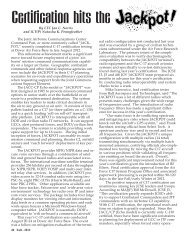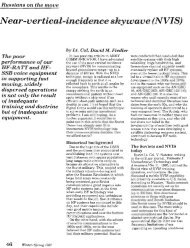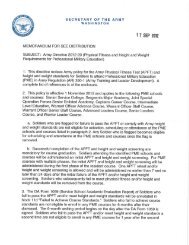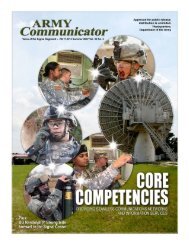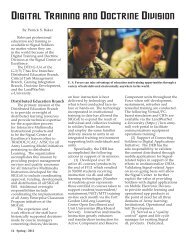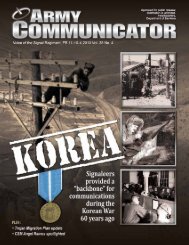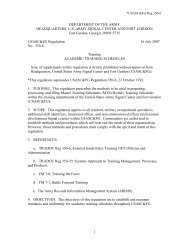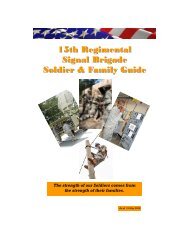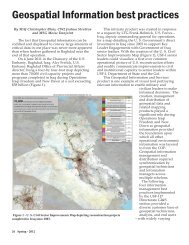AC Summer 08 WIN-T Online - United States Army Signal Center of ...
AC Summer 08 WIN-T Online - United States Army Signal Center of ...
AC Summer 08 WIN-T Online - United States Army Signal Center of ...
Create successful ePaper yourself
Turn your PDF publications into a flip-book with our unique Google optimized e-Paper software.
done in an integrated, harmonious<br />
fashion. Changes to the<br />
settings or behaviors <strong>of</strong> an information<br />
assurance component, for<br />
example, can be addressed in the<br />
larger context <strong>of</strong> the overall network,<br />
and implications or changes to the<br />
other parts <strong>of</strong> the network can be<br />
made without tedious data re-entry<br />
by an operator. In addition, the<br />
operator has a single, intuitive user<br />
interface for all aspects <strong>of</strong> the<br />
NetOps process, to include spectrum<br />
management. This simplifies new<br />
equipment training, sustainment<br />
training, and resident training for<br />
the operators and trainers alike.<br />
The <strong>WIN</strong>-T Increment 2<br />
network is a mobile, ad-hoc network.<br />
As such, it creates some interesting<br />
NetOps challenges, that themselves<br />
represent a second paradigm shift<br />
from classical network operations<br />
thinking.<br />
In a mobile, ad-hoc network,<br />
the up/down status <strong>of</strong> an individual<br />
link is secondary to the connectivity<br />
<strong>of</strong> nodes. As the various network<br />
elements move as a function <strong>of</strong> the<br />
flow <strong>of</strong> battle, it is natural for any<br />
number <strong>of</strong> links to be “down,” but<br />
the important question is whether<br />
the various network elements, and<br />
the battle command systems they<br />
connect, can pass data with the<br />
requisite speeds <strong>of</strong> service. This<br />
requires a fundamental shift in user<br />
perspective, from a link-based, static<br />
view <strong>of</strong> the network to a connectivity-based,<br />
dynamic view <strong>of</strong> the<br />
network. TCM N&S is working with<br />
PM <strong>WIN</strong>-T and the user community<br />
to address user interface and training<br />
associated with this paradigm<br />
shift.<br />
With a mobile, ad-hoc network<br />
operating in a multi-tier transmission<br />
environment (terrestrial air,<br />
space), it is important to be able to<br />
predict a priori how the network will<br />
behave spatially and temporally as<br />
an operation or exercise progresses.<br />
This prediction needs to account for<br />
geographical features, the variations<br />
in traffic volume <strong>of</strong>fered to the<br />
network as a function <strong>of</strong> battle phase<br />
and unit position, and spectral<br />
interference and its attending<br />
bandwidth effects, both within the<br />
The <strong>WIN</strong>-T Increment<br />
2 network is a mobile,<br />
ad-hoc network. As<br />
such, it creates some<br />
interesting NetOps<br />
challenges, that<br />
themselves represent<br />
a second paradigm<br />
shift from classical<br />
network operations<br />
thinking.<br />
network and between the network<br />
and the background environment.<br />
All this must be accomplished in a<br />
time frame that is relevant tactically.<br />
With this information, a network<br />
operator can see where, both in<br />
space and time, the network fails to<br />
meet commanders’ delivery priorities,<br />
and can then allocate or reallocate<br />
resources from the terrestrial,<br />
air, or space layer to meet the<br />
commander’s operational needs.<br />
U.S. <strong>Army</strong> Training and<br />
Doctrine Command has mandated<br />
that the <strong>WIN</strong>-T program follow netcentric<br />
principles, and has prescribed<br />
the Net-Centric KPP for the<br />
program. The <strong>WIN</strong>-T NetOps<br />
system is built upon net-centric<br />
principles and follows the Network-<br />
Centric Operations and Warfare<br />
reference model and Network-<br />
Centric Enterprise Services guidance.<br />
The s<strong>of</strong>tware is designed<br />
around a service-oriented concept,<br />
with functions or tasks represented<br />
by services. This enhances the<br />
ability to “expose” or export services<br />
to other NetOps solutions (e.g.,<br />
Future Combat Systems Network<br />
Management Systems)or conversely<br />
import or subscribe to externally<br />
provided services (e.g., Joint Tactical<br />
Radio Systems Wideband Networking<br />
Waveform management services,<br />
Theater Network Operations and<br />
Securities <strong>Center</strong> trouble ticketing<br />
services).<br />
Based upon guidance from the<br />
<strong>Army</strong> and Department <strong>of</strong> Defense,<br />
<strong>WIN</strong>-T NetOps is being built in an<br />
incremental fashion, following the<br />
incremental development <strong>of</strong> the<br />
network. Increment 1 will involve<br />
the deployment <strong>of</strong> stand-alone<br />
government <strong>of</strong>f-the-shelf and<br />
commercial <strong>of</strong>f-the-shelf-based<br />
products for network operations<br />
akin to those being used for the JNN<br />
network. Increment 2 introduces the<br />
<strong>WIN</strong>-T net-centric NetOps architecture,<br />
introduces capabilities required<br />
for effective management and<br />
control <strong>of</strong> a mobile-ad-hoc network,<br />
and begins the integration <strong>of</strong> the<br />
stand-alone COTS and GOTS<br />
products. Increment 3 refines the<br />
mobile, ad-hoc functions, provides<br />
additional capability for the planning<br />
and management <strong>of</strong> battle<br />
command applications and services,<br />
and continues the integration <strong>of</strong> the<br />
GOTS and COTS solutions. Increment<br />
4 completes the NetOps<br />
development with refinements <strong>of</strong><br />
previous functions and completes<br />
replacement <strong>of</strong> COTS and GOTS<br />
stand-alone packages.<br />
<strong>WIN</strong>-T provides an integrated<br />
NetOps solution as part <strong>of</strong> an overall<br />
network design that meets the<br />
performance based operational<br />
requirements set forth by the <strong>Army</strong>.<br />
This integration provides a unified<br />
NetOps approach that is harmonized<br />
with other critical network elements<br />
to provide positive control <strong>of</strong> a<br />
mobile, ad-hoc network, and a<br />
simultaneous providing <strong>of</strong> the<br />
required bandwidth and speed <strong>of</strong><br />
service to the commander, the<br />
command staff, and their respective<br />
battle command applications.<br />
Editor’s Note: Paul Wein<br />
contributed to this report.<br />
Mr. Wagner is a systems engineer<br />
in the Network Operations area <strong>of</strong> the<br />
Project Manager, Warfighter Information<br />
Network-Tactical <strong>of</strong>fice. He received a<br />
B.S. in electrical engineering in 1979<br />
from West Virginia University, and<br />
masters in engineering administration in<br />
1988 from George Washington University,<br />
an M.S. in electrical engineering in<br />
1992 from The Johns Hopkins University,<br />
and a Ph.D in Information Systems in<br />
2003 from Kennedy Western University.<br />
<strong>Army</strong> Communicator 51



